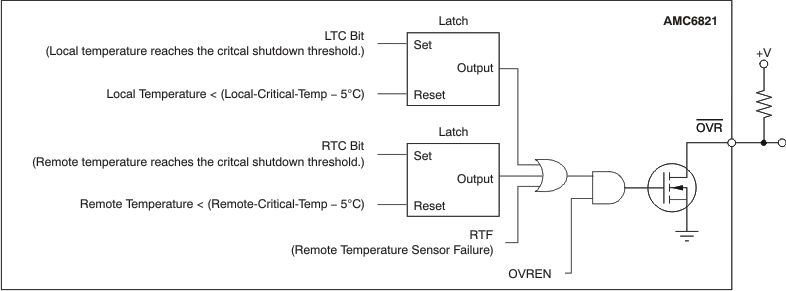ZHCSR80A June 2009 – January 2023 AMC6821-Q1
PRODUCTION DATA
- 1 特性
- 2 应用
- 3 说明
- 4 Revision History
- 5 说明(续)
- 6 Pin Configuration and Functions
- 7 Specifications
-
8 Detailed Description
- 8.1 Functional Block Diagram
- 8.2 Feature Description
- 8.3 Device Functional Modes
- 8.4 Programming
- 8.5 Register Map
- 9 Application and Implementation
- 10Device and Documentation Support
- 11Mechanical, Packaging, and Orderable Information
8.2.9.1 OVR Pin
OVR is an open-drain output pin that works as an over-critical temperature limit (shutdown threshold) indicator and remote sensor failure indicator. Figure 8-20 shows the architecture. Setting the OVREN bit of Configuration Register 4 to '1' enables this pin; clearing OVREN ('0') disables it. When disabled, the OVR pin is in a high-impedance status. When enabled, the status is controlled by the over-critical temperature flag and remote sensor failure flag bits of the Status Registers.
When the temperature is over the critical limit (shutdown threshold), the corresponding over-critical limit flag of the Status Register (RTC for the remote channel and LTC for the local channel) is set ('1'). This flag is cleared ('0') when reading the Status Registers. Once cleared, this bit is not reasserted until the temperature falls 5°C below the exceeded critical limit, even if the over-critical limit condition persists. When the temperature is equal to or above the critical temperature limit, the OVR pin is asserted (active low) to indicate this critical condition. As the over-critical temperature limit indicator, the OVR pin remains low once asserted until the measured temperature falls 5°C below the exceeded critical limit.
 Figure 8-20 OVR Pin
Figure 8-20 OVR PinWhen a remote temperature sensor failure condition is detected (either short-circuit or open-circuit), the remote temperature sensor failure bit (RTF) in Status Register 1 (bit 5, 0x02) is set ('1') and the OVR pin is forced low no matter what the status of RTFIE is. This value indicates a remote sensor failure condition. Once this condition occurs, the RTF bit remains '1' and the OVR pin stays low until a power-on reset or software reset is issued, regardless if the failure condition continues thereafter. RTF = 1 also generates an RTF interrupt through the SMBALERT pin when RTFIE = 1.